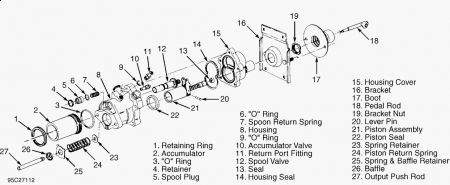First things first...test the brake fluid as described, , but the hydraboost may need to be replaced.
Condition/Concern: On vehicles with hydro-boost, customers may notice during full lock turns or near full lock turns that the brake pedal will move down or self apply. This can be caused by the internal dump valve of the hydro-boost not seating properly due to contamination in the steering system. The hydro-boost assembly is not tolerant to certain types of contaminates that may be present in the steering system. Â Recommendation/Instructions: The Hydro-boost system is not serviceable, and must be replaced. Before replacement of the hydro-boost system, the entire steering system (power steering pump, lines, and the gear box) must be flushed to avoid reoccurrence. Â Source: GM Preliminary Information Bulletin #PIT3665A - (Jul 1, 2008)
Testing:
PRELIMINARY CHECKS Check engine idle speed. Check all power steering hoses and brake lines for leaks or restrictions. Fill master cylinder with brake fluid. Fill power steering pump reservoir with power steering fluid. Check for air in power steering fluid reservoir. Check power steering belt tension and condition. Check power steering pump pressure. ACCUMULATOR LEAK-DOWN TEST 1. Start engine. Charge accumulator by applying brakes or turning steering wheel from stop-to- stop. Turn engine off. Allow vehicle to sit for one hour. Apply and release brake pedal. There should be at least 2 power-assisted applications. This indicates the accumulator is retaining a charge. 2. If accumulator does not retain charge for one hour but functions normally immediately after charging, replace accumulator valve. See OVERHAUL . If accumulator can be heard charging and discharging but does not hold a charge, replace accumulator valve. See OVERHAUL . 3. Discharge accumulator by pressing brake pedal several times. Attempt to rotate accumulator can in respect to housing. If it is possible to rotate can, accumulator has lost its gas charge. Replace accumulator assembly. BOOSTER FUNCTIONAL TEST With engine off, press brake pedal several times to deplete accumulator reserve. Press and hold brake pedal with about 40 lbs. (18 kg) pressure. Start engine. Brake pedal should fall slightly, then push back against foot. If no action is felt, booster is not operating properly. NOTE: Inoperative Hydro-Boost cannot cause noisy brakes, fading brake pedal or pulling brakes. If one of these conditions exists, other components of brake system are at fault.
11/1/2009 ...
Bleeding:
BLEEDING HYDRO-BOOST SYSTEM 1. Fill power steering pump reservoir and leave undisturbed for at least 2 minutes. Start engine and run momentarily. Add fluid if necessary. Repeat until fluid level remains constant with engine running. 2. Stop engine. Raise front wheels off the ground. Turn steering wheel from stop-to-stop. Add fluid if necessary. Lower vehicle. 3. Start engine. Press brake pedal several times while turning steering wheel from stop-to-stop. Turn engine off. Press brake pedal several times to exhaust accumulator pressure. Check fluid level. Add fluid (if necessary). 4. If fluid is foamy, let vehicle stand for several minutes, then repeat step 3). Air in system will cause fluid level to rise with engine off. Continue to bleed system until all air is expelled. If all air is not expelled after bleeding system, check power steering system for problem.

Sunday, November 1st, 2009 AT 7:58 AM

